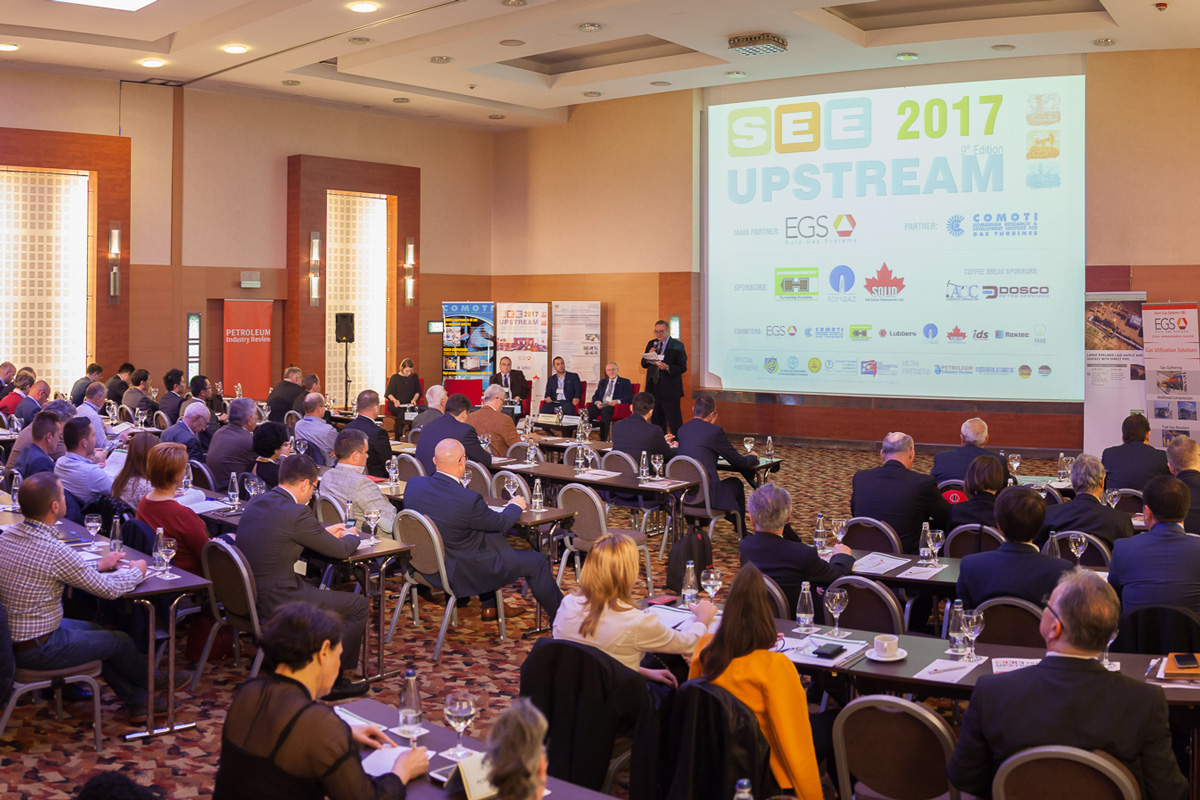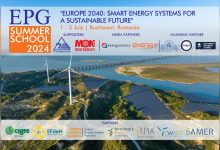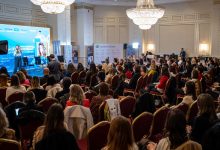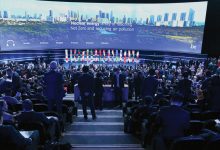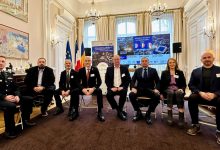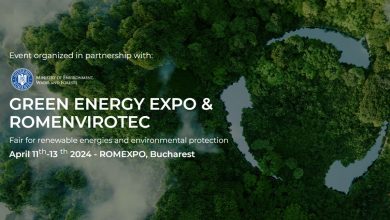SEE Upstream Annual Conference & Exhibition 2017
Offshore & onshore technology in the Black Sea region
During May 20-21, the SEE UPSTREAM Annual Conference & Exhibition 2017 was held in Bucharest, organized by the Petroleum Club of Romania and Industry Media Vector, the editor of the Petroleum Industry Review, with the support of CNR-CME.
The 9th edition of the annual conference dedicated to the Upstream segment, a major event of the oil and gas industry, brought together managers from Romania and South-Eastern Europe, Romanian and international experts, officials from regulatory bodies, consultants and specialists in the field for a fresh exchange of ideas and opinions on the most advanced technical and scientific solutions for the benefit of the industry’s sustainable development.
The debates focused in particular on the current situation of the energy industry, the priorities of the National Energy Strategy, legislative measures, implications, dynamics and forecasts regarding the oil prices, challenges to the oil and gas industry, resource efficiency programmes, and cost savings, safety and security at work, companies’ strategies and future plans.
Structured in the form of five technical sessions and two keynote speeches, the conference has occasioned interactive discussions between the speakers and the audience, to better understand the topics presented.
Opening the conference, Petroleum Club of Romania President Andrew Costin pointed to some of the most important challenges of the industry, underlining especially the issue of human capital, referring not only to specialists who have left the oil and gas sector, given one of the most volatile periods in the history of the oil and gas sector, and especially the decrease of young people’s interest in this economic branch.
In the regional context, Romania’s situation, with pluses and minuses, was analysed by Eugenia Gusilov, ROEC Director, who sent a warning message on weaknesses: decrease in international credibility, vulnerability of national security, sharp deterioration of reputation. Although progress has been made – the evolution of the BRUA project, the liberalization of domestic gas prices (April 1, 2017), the BSOG announcement on the start of gas production in the Black Sea in 2019 – unresolved issues and impediments still remain: NAMR’s 11th round, the fiscal package for the oil and gas sector, the decrease in domestic gas output, the increase of gas imports.
Production, enhanced oil recovery (eor) activities, workover and onshore & offshore operations
The major topics of the first session focused on production activities, on the enhanced recovery factor (EOR), workover and onshore and offshore operations in the oil and gas industry. Thus, representatives of the largest oil and gas producer in South East Europe – OMV Petrom, underscored the importance of a technical opportunity to reduce production costs for natural gas wells. The technological solution presented by Dumitru Gherghiceanu – Senior Department Manager, and Andrei Ion Corneliu – Drilling Engineer, pointed to the drilling and cementing of production wells in the drilling process. According to them, the new concept proposed by OMV Petrom, applicable only to gas wells, proved to be feasible from the technical and economic point of view, being successfully implemented in Romania.
In his turn, Eugen Sorescu – Director of Exploration Department with Romgaz, the most important producer and main supplier of natural gas in Romania, reiterated in his presentation “Risks and Challenges in Petroleum Exploration Projects” the company’s exploration strategy, which includes the continuation of ongoing projects, the analysis of new opportunities for perimeter acquisition, adopting the most modern practices, improvement of risk analysis, portfolio management and continuous staff training. Properly assessing and managing the main challenges and risks of exploration and production projects, whether technical, tax, economic or political, ultimately leads to the profitability of projects, the specialist has emphasized. In terms of the Romgaz achievements, during 2012-2016, these include: over 80 exploration wells; 4,000 sq km of seismic 3D, 1,100 km of 2D seismic profiles, 1,200 magnetotelluric stations; 7,000 geochemical samples taken; over 11 bn cm of contingent resources; two discoveries summing up 27 bn cm contingent resources (in 2016).
A success story was revealed to the audience by Alexandra Damascan Armegioiu – Winstar Satu Mare Country Manager, Serinus Energy subsidiary in Romania. The Satu Mare Moftinu Project, the 29th largest of the 97th Pannonian Basin, has attracted substantial Canadian investments and the development continues, the first gas production being expected in the first quarter of 2018. Also, the 3D seismic prospects are going on in the area, aiming to discover new perimeters similar to the potential of the Moftinu project, the regions of interest for the company being Santau, Madaras, Berveni, Nisipeni. It is to be highlighted the important local and national economic benefits, as well as the employment and business opportunities the project offers to citizens and to the business environment in Romania.
Surviving the low-cost industry environment: pragmatic strategies to improve the safety, reliability and value of equipment and processes
The session on health, security and safety (HSE) highlighted key issues regarding pragmatic strategies to increase the safety, reliability and efficiency of the equipment and processes. Constantin Gheorghe – Chairman of the Regulatory Authority for the Black Sea Oil Offshore Operations noted the intensification of activities in the Romanian Black Sea sector. Operations move to the deepwater area, which involves increased challenges and operational hazards while the legislation in the field is still at an early stage of development. The expert cited the main international legislative documents on the protection of the Black Sea against pollution, while observing the poor level of the legislation in Romania in this area. The response to pollution is mainly based on on-call arrangements with the private sector or provided by the Ministry of Defence or the Ministry of Internal Affairs, but they might not be sufficient in number, response time and availability, as the legislation on the safety of offshore oil and gas operations is incomplete, there are no agreements in force with the neighbouring countries for support, etc. Thus, the newly set up new authority will have to ensure, among other responsibilities, the regulation of offshore oil and gas activities as well as the connection between operators, owners, local authorities and competent authorities in other countries. It will also need to develop a regional emergency response framework with all countries around the Black Sea and to periodically conduct exercises on various scenarios involving offshore oil and gas operations.
On the other hand, Christopher Hawkes, Safety Director with IOGP, mentioned the most important Life Saving Rules (LSR) in an economically hostile environment, indicating the main measures to prevent labour incidents in the oil and gas sector. A recent analysis of the association highlighted the fact that approximately 75% of the 332 fatal work incidents during 2011-2015 could have been prevented by strict compliance to the LSR.
Recent developments, priorities and directions of interest
The second day of the conference started with a brief review of the latest developments in the exploration and production segment, delivered by Prof. Niculae Napoleon Antonescu PhD – Honorary Rector of the Petroleum-Gas University, followed by the interventions of the representatives of the regulatory bodies in the field. Talking about the recent personnel layoffs in the share of 10-20%, the massive decrease of the works and, last but not least, about the serious situation of the drilling contractors, he mentioned the encouraging issues, respectively OMV Petrom’s drilling activity revitalization, liberalization of gas prices, the favourable prospects for onshore and offshore gas exploration.
Sorin Gal – National Agency for Mineral Resources Director General, assured the audience that there is a government programme which includes clear steps regarding the drafting of the Law on Royalties, which is due to be concluded probably at the end of June, and the Petroleum Law will be finalized in October and then submitted to Parliament. He also pointed out that currently there are two main directions of interest: the onshore deep drilling area and the Black Sea region. The official also said that NAMR is working together with the Black Sea operators on drafting a law to help solve some problems related to undercrossing the beaches, the access through leased blocks to title-holders, building permits in the Black Sea coastal zone, a bill which will give additional impetus to surface equipment.
In addition, National Authority for Energy Regulation President Niculae Havrileţ referred to the regulation of the natural gas market, pointing out that currently the Upstream segment, where the regulation is insignificant, ensures 95-97% of the domestic gas consumption. He also recalled the new obligation of the Upstream pipeline operators to respond to the requests coming from third parties. Another important aspect was the energy mix to be used over the next 20 years, a mix where natural gas is considered the ideal partner for renewable energies. Romania enjoys a favourable position due to the resources in the Black Sea, the expectations being related to the first gas production announced by BSOG for 2019 and the exploitations estimated by OMV Petrom, ExxonMobil and Romgaz after 2020. Also, the ANRE President emphasized the importance of the project for building the first network of filling stations for compressed natural gas (CNG) vehicles in Romania.
Prof. Ionuţ Purica – Energy and Environment Expert within the Romanian Academy prelected on innovations, new technologies and hydrocarbons replacement. Analysing the European Union’s directions and development objectives – the Europe 2030 project, the expert noted that in the five pillars there are new concerns related to the interconnection of networks (electricity and gas), research and innovation (R&I), competitiveness, for speeding up the transformation of the European energy system. At the same time, emphasis is laid on directing and integrating the priorities.
In response to the oilmen concerns, the expert concluded, based on a simple mathematical calculation, that it is unlikely that in the next 33 years electric vehicles will replace diesel and gasoline motorcars.
Innovative solutions, cutting-edge technologies and equipment
Continuing the idea previously presented by the Romanian Academy’s expert, the following sessions emphasized the role and importance of research and innovation in the development of the oil and gas industry. The representatives of the companies attending the event, both with exposures and products, have highlighted innovative solutions, cutting-edge technologies and equipment.
Thus, the solutions offered by Euro Gas Systems based in Târgu Mures, official distributor of the renowned compressors manufacturer Ariel Corporation, include: natural gas compression units, based on reciprocating and screw compressor technology with capabilities of packaging gas compressors up to 5000 HP both engine and electric driven, overhaul services for the existing compression units, the manufacture of pressure vessels and other metallic structures, air-cooled hot exchangers, complete non-destructive control services in the own laboratory and at the site. Euro Gas Systems (EGS) provides packaged gas compressors for the entire industry operations – Upstream, Midstream and Downstream. Claudiu Orban, Sales Manager, highlighted the efficiency of gas compressing equipment for well heads, especially for marginal gas wells, exemplifying by eloquent case studies. He added that although the concept was not developed by EGS, the company managed to integrate this concept into a product complying with European standards, which complies with the PED and ATEX directives. To name a few of the advantages, Claudiu Orban pointed out the increased production capability, prolonged well life and nevertheless increased reserves.
Leonard Trifu – Marketing Manager INCDT Comoti, added to the range of solutions for the oil and gas industry a wide range of high-efficiency equipment and special services – compressing and recovery equipment for natural gas, centrifugal air compressors, gas turbocharger, gas centrifugal electro-compressor, automation, assembling, maintenance, service, 3D modelling, CFD analysis, test benches for gas turbines and compressors, etc. In addition, the Romanian Research & Development Institute for Gas Turbines is distinguished by the development of international cooperation programmes and technical-scientific partnerships with prestigious institutions and companies in Europe. Also, the Institute’s constant concerns include the ecological, rational and efficient exploitation of natural resources; the development of new technologies and equipment designed to protect and be environment friendly.
The efficiency of trenchless technology, with applications in various fields of activity, including the oil and gas industry, was explained by Dymitr Petrow-Ganew – Area Sales Manager Central and Eastern Europe, Herrenknecht. The latest equipment and solutions for pipeline crossing – faster, more economical, safe and environment friendly, have attracted the attention of the audience, interested in modern drilling systems with outstanding performance produced by the German company. The Herrenknecht HDD (Horizontal Drilling) equipment is used worldwide for the installation of oil and gas pipelines, as well as for water and sewage pipelines.
In order to increase the efficiency of the drilling operations, while cutting the costs, Tomax proposes a new concept of tools – Anti-Stick-Slip Tool (AST), an axial and torsion vibration shock absorber. According to Morten Granhøy-Lieng – VP Operations, the use of the new tool improves the efficiency of the drill bit, prevents the destructive effect of vibration and increases the ROP.
The digital transformation of the exploration and production sector is still a challenge to the oil and gas industry, characterized by a huge amount of organizational, geographic and geopolitical data and information. And this is not just a technological challenge, it also involves a change of mentality at the level of organizations, from managers to employees, said Stefan Blendinger PhD, Siemens Austria representative. However, the benefits are indisputable, whereas the adoption of cutting-edge technology and integrated data management contribute to the sustainable development of the industry.
NA Solid Petroserve, a Canadian petroleum service company specializing in slickline & wireline services and surface well production testing services, provides customers with tools, devices and ancillary equipment to increase operational performance. The wide range of slickline & wireline services includes pressure and temperature recorders, as well as operations to control the flow of fluids. Full well testing services include DST, new wells tests, isolated wells testing and production in production tanks, production testing in production parks, well testing on the well production line. The company also provides high-quality data acquisition services with connection capabilities to existing pressure/temperature measuring devices. In addition, it provides full productivity analysis services (using wellbore flow equations, determination of the absolute flow potential), including the recommendations for production design. Besides the well testing services, company’s President Robert Louis Fox listed the EPF solutions, the BHP data acquisition systems, the PVT analyses, with various industry applications.
The technical expertise of technological pipelines by combined method with Guided Wave (GWT) and potential gradient (Direct Current Voltage Gradient – DCVG) was the subject of the presentation delivered by the IPM-Partners representative, Dragos Toma, Engineering & Inspection Manager. The advantages of using the combined method include: the high probability of detecting possible defects in tubular material (95-98%); high accuracy of localization for remedy; does not require removal of the pipeline or the changing of the operating parameters during the examinations, both methods being non-destructive and non-invasive. Given the partners’ needs, regarding the most rigorous maintenance of the equipment, the company has developed, over time, more performing technical investigation models.
Prof. Mihail Minescu PhD – Vice-Rector of Petroleum-Gas University, is partisan of the modernization of the copper pipe assembly systems for natural gas installations (although the process of assembly by pressing of the proposed copper pipes and fittings has been approved by the competent bodies, it hasn’t been introduced in the ANRGN norm and cannot be applied in Romania, although the procedure is used by most European countries). The advantages of copper pipes compared to steel – higher corrosion resistance, smaller wall thickness, better behaviour at both low and high temperatures, and simpler assembly technologies – recommend this procedure.
Final conclusions
Overall, since the spring event of 2016, the Upstream segment (exploration and production) of the oil and gas industry has passed through a period marked by a slight recovery in oil prices, facing the continuous decrease in capital expenditures, the postponing of major investment projects, the fall in operational expenses, decrease of production and in number of employees, the lack of fiscal framework needed for the sector’s operations. Good news comes in view of the expected results of the Black Sea exploration, onshore deep drilling projects, the BRUA project development. On the other hand, the price pressure has stimulated research and innovation, including in terms of cutting unit costs of oil production and return on the invested capital.
This year, the conference has also attracted, as usually, the interest of the Upstream specialists in the oil and gas industry, who had the opportunity to meet and discuss with the representatives of the regulatory bodies in the field, to discuss with the colleagues the latest solutions to overcome the technical and operational challenges posed by a so demanding and vulnerable work environment, and to connect directly with the industry providers of leading solutions and services.


